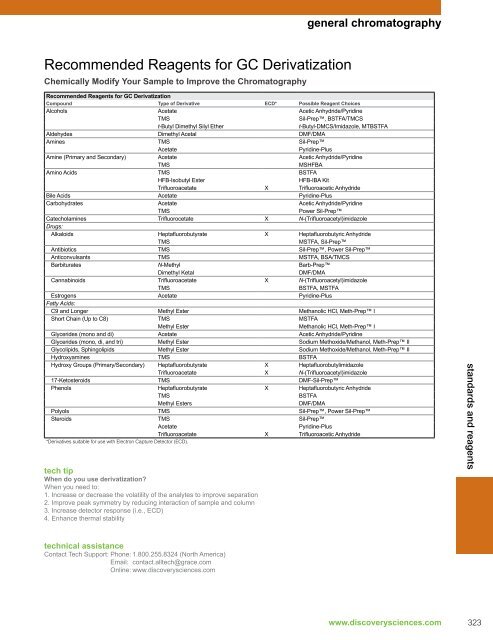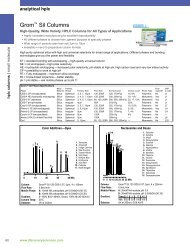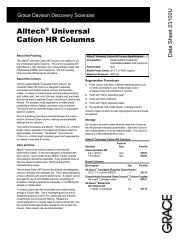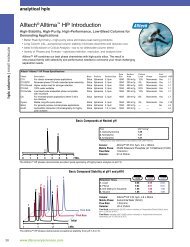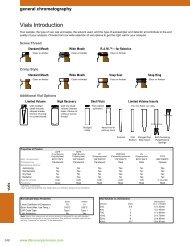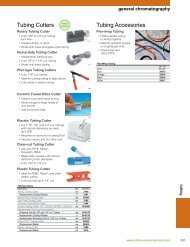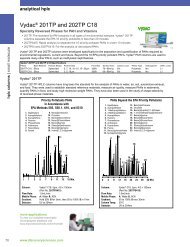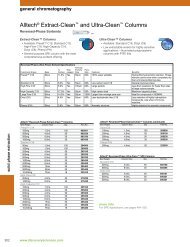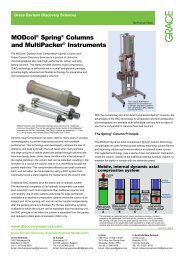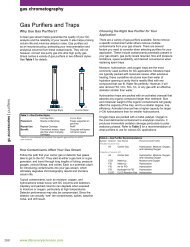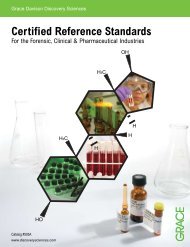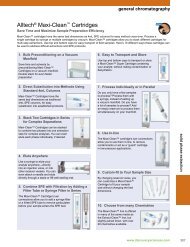Derivatization Reagents - Grace Davison Discovery Sciences
Derivatization Reagents - Grace Davison Discovery Sciences
Derivatization Reagents - Grace Davison Discovery Sciences
Create successful ePaper yourself
Turn your PDF publications into a flip-book with our unique Google optimized e-Paper software.
Recommended <strong>Reagents</strong> for GC <strong>Derivatization</strong><br />
Chemically Modify Your Sample to Improve the Chromatography<br />
general chromatography<br />
Recommended <strong>Reagents</strong> for GC <strong>Derivatization</strong><br />
Compound Type of Derivative ECD* Possible Reagent Choices<br />
Alcohols Acetate Acetic Anhydride/Pyridine<br />
TMS Sil-Prep, BSTFA/TMCS<br />
t-Butyl Dimethyl Silyl Ether t-Butyl-DMCS/Imidazole, MTBSTFA<br />
Aldehydes Dimethyl Acetal DMF/DMA<br />
Amines TMS Sil-Prep<br />
Acetate Pyridine-Plus<br />
Amine (Primary and Secondary) Acetate Acetic Anhydride/Pyridine<br />
TMS MSHFBA<br />
Amino Acids TMS BSTFA<br />
HFB-Isobutyl Ester HFB-IBA Kit<br />
Trifluoroacetate X Trifluoroacetic Anhydride<br />
Bile Acids Acetate Pyridine-Plus<br />
Carbohydrates Acetate Acetic Anhydride/Pyridine<br />
TMS Power Sil-Prep<br />
Catecholamines Trifluorocetate X N-(Trifluoroacetyl)imidazole<br />
Drugs:<br />
Alkaloids Heptafluorobutyrate X Heptafluorobutyric Anhydride<br />
TMS MSTFA, Sil-Prep<br />
Antibiotics TMS Sil-Prep, Power Sil-Prep<br />
Anticonvulsants TMS MSTFA, BSA/TMCS<br />
Barbiturates N-Methyl Barb-Prep<br />
Dimethyl Ketal DMF/DMA<br />
Cannabinoids Trifluoroacetate X N-(Trifluoroacetyl)imidazole<br />
TMS BSTFA, MSTFA<br />
Estrogens Acetate Pyridine-Plus<br />
Fatty Acids:<br />
C9 and Longer Methyl Ester Methanolic HCl, Meth-Prep I<br />
Short Chain (Up to C8) TMS MSTFA<br />
Methyl Ester Methanolic HCl, Meth-Prep I<br />
Glycerides (mono and di) Acetate Acetic Anhydride/Pyridine<br />
Glycerides (mono, di, and tri) Methyl Ester Sodium Methoxide/Methanol, Meth-Prep II<br />
Glycolipids, Sphingolipids Methyl Ester Sodium Methoxide/Methanol, Meth-Prep II<br />
Hydroxyamines TMS BSTFA<br />
Hydroxy Groups (Primary/Secondary) Heptafluorobutyrate X Heptafluorobutylimidazole<br />
Trifluoroacetate X N-(Trifluoroacetyl)imidazole<br />
17-Ketosteroids TMS DMF-Sil-Prep<br />
Phenols Heptafluorobutyrate X Heptafluorobutyric Anhydride<br />
TMS BSTFA<br />
Methyl Esters DMF/DMA<br />
Polyols TMS Sil-Prep, Power Sil-Prep<br />
Steroids TMS Sil-Prep<br />
Acetate Pyridine-Plus<br />
Trifluoroacetate X Trifluoroacetic Anhydride<br />
*Derivatives suitable for use with Electron Capture Detector (ECD).<br />
tech tip<br />
When do you use derivatization?<br />
When you need to:<br />
1. Increase or decrease the volatility of the analytes to improve separation<br />
2. Improve peak symmetry by reducing interaction of sample and column<br />
3. Increase detector response (i.e., ECD)<br />
4. Enhance thermal stability<br />
technical assistance<br />
Contact Tech Support: Phone: 1.800.255.8324 (North America)<br />
Email: contact.alltech@grace.com<br />
Online: www.discoverysciences.com<br />
www.discoverysciences.com<br />
standards and reagents<br />
323
standards and reagents<br />
general chromatography<br />
Ready-To-Use Silylation Mixes<br />
Silylation replaces an active hydrogen atom (-OH, -NH2,<br />
-NHR, -SH) with a silyl group. Generally, it reduces the<br />
polarity of the compound and decreases possibility of<br />
hydrogen bonding.<br />
Sil-Prep (HMDS:TMCS:pyridine) <strong>Reagents</strong><br />
• General purpose reagent for making TMS derivatives<br />
Sil-Prep<br />
Description Qty. Part No.<br />
Sil-Prep 10 x 1mL 18013<br />
tech tip<br />
Silylation Reagent Strength<br />
HMDS<br />
TMCS<br />
Sil-Prep<br />
MSTFA<br />
MSHFBA<br />
BSA<br />
BSTFA<br />
TMSIM<br />
BSTFA +1% TMCS<br />
POWER Sil-Prep<br />
324 www.discoverysciences.com<br />
5421<br />
t-Butyldimethylchlorosilyl/Imidazole <strong>Reagents</strong><br />
• Derivatives of alcohols are more stable than TMS ethers<br />
to hydrolysis<br />
t-Butyldimethylchlorosilyl/Imidazole<br />
Description Qty. Part No.<br />
t-BuDMCS/Imidazole 10 x 1mL 18028<br />
POWER Sil-Prep (TMSIM:BSA:TMCS) <strong>Reagents</strong><br />
• Powerful reagent for sterically hindered groups<br />
POWER Sil-Prep<br />
Description Qty. Part No.<br />
POWER Sil-Prep 10 x 1mL 18012<br />
DMF Sil-Prep (HMDS:TMCS:DMF) <strong>Reagents</strong><br />
• Prevents enolization of keto groups<br />
DMF Sil-Prep<br />
Description Qty. Part No.<br />
DMF Sil-Prep 10 x 1mL 18015<br />
tech tip<br />
What are the requirements for a good reagent?<br />
It will:<br />
1. Not cause any rearrangements or structural changes in<br />
the analyte<br />
2. Produce a reaction that is 95–100% complete<br />
3. Produce a stable derivative<br />
4. Not contribute to loss of sample during the reaction<br />
5. Produce a derivative that is inert to the column and connections<br />
6. Not produce interfering byproducts<br />
related product<br />
Looking for a Safe and Easy<br />
Way to Open Ampules?<br />
Try the Ampule Cracker.<br />
See page 380.<br />
4958
Individual Silylation <strong>Reagents</strong><br />
BSA [N,O-bis(trimethylsilyl)acetamide]<br />
• Powerful silylating reagent and solvent for polar<br />
compounds<br />
BSA<br />
Description Qty. Part No.<br />
BSA 10mL 18056<br />
BSA 25mL 18057<br />
BSA 10 x 1mL 18034<br />
BSTFA (N,O-bis(trimethylsilyl)trifluoroacetamide)<br />
• More volatile reagent and byproducts compared to BSA<br />
• Powerful silylating reagent; even more effective combined<br />
with TMCS as a catalyst<br />
BSTFA<br />
Description Qty. Part No.<br />
BSTFA 10mL 18085<br />
BSTFA 10 x 1mL 18040<br />
BSTFA + 1% TMCS 10mL 18087<br />
BSTFA + 1% TMCS 10 x 1mL 18089<br />
CMDMCS<br />
• Longer retention times than TMCS derivatives<br />
• Enhanced ECD response<br />
CMDMCS<br />
Description Qty. Part No.<br />
CMDMCS 5mL 18031<br />
DMCS (Dimethylchlorosilane)<br />
• DMS derivatives are more sensitive to hydrolysis than<br />
TMS derivatives<br />
DMCS<br />
Description Qty. Part No.<br />
DMCS 3 x 10mL 18071<br />
HMDS (Hexamethyldisilazane)<br />
• Slow and inefficient used alone<br />
• Very effective in combination with TMCS<br />
HMDS<br />
Description Qty. Part No.<br />
HMDS 25mL 18069<br />
HMDS 10 x 1mL 18003<br />
MSHFBA (N-Methyl-<br />
N-trimethylsilylheptafluorobutyramide)<br />
• Similar to MSTFA but does not produce harmful deposits<br />
in FID<br />
MSHFBA<br />
Description Qty. Part No.<br />
MSHFBA 10mL 214610<br />
MSHFBA 20 x 1mL 2146201<br />
general chromatography<br />
MSTFA<br />
(N-Methyl-N-trimethylsilyltrifluoroacetamide)<br />
• Ideal reagent for drug analysis because excess reagent<br />
and byproducts elute during solvent delay<br />
• May be used directly on HCl salts of compounds<br />
MSTFA<br />
Description Qty. Part No.<br />
MSTFA 10mL 18061<br />
MSTFA 1 x 1mL 18038<br />
MTBSTFA [N-(tert-butyldimethylsilyl)-<br />
N-methyltrifluoroacetamide]<br />
• Derivatives more stable than common TMS derivatives<br />
• Produces a distinct M-57 ion in GC/MS analysis<br />
• Even more effective when combined with TBDMCS as<br />
a catalyst<br />
MTBSTFA<br />
Description Qty. Part No.<br />
MTBSTFA 10 x 1mL 18097<br />
MTBSTFA 10mL 18102<br />
MTBSTFA + 1% TBDMCS 10 x 1mL 18155<br />
MTBSTFA + 1% TBDMCS 10mL 18148<br />
TMCS (Trimethylchlorosilane)<br />
• Similar to HMDS when used alone<br />
• Very effective as a catalyst to other reagents<br />
TMCS<br />
Description Qty. Part No.<br />
TMCS 3 x 10mL 18091<br />
TMCS 10 x 1mL 18084<br />
TMSIM (N-Trimethylsilylimidazole)<br />
• Preferentially silylates hydroxyl groups<br />
• Best silylation reagent when water is present<br />
TMSIM<br />
Description Qty. Part No.<br />
TMSIM 10 x 1mL 18050<br />
Glass Conditioning Reagent<br />
Glass-Prep (5% DMDCS in toluene)<br />
• Deactivate any glass surface<br />
Glass-Prep<br />
Description Qty. Part No.<br />
Glass-Prep 100mL 9700<br />
Glass-Prep 400mL 2233<br />
DMDCS, Neat 10 x 5mL 18090<br />
www.discoverysciences.com<br />
standards and reagents<br />
325
standards and reagents<br />
general chromatography<br />
Alkylation (Esterification)<br />
<strong>Reagents</strong><br />
Alkylation replaces an acidic hydrogen (carboxylic acids,<br />
phenols) with an alkyl group. Alkyl esters are extremely stable<br />
and can be stored for long periods of time.<br />
Meth-Prep I<br />
• On-column derivatization<br />
• Aqueous solution does not give solvent peak<br />
Meth-Prep I is a 0.2N aqueous solution of<br />
(m-trifluoromethylphenyl) trimethylammonium hydroxide.<br />
When the reagent is mixed with fatty acids and then<br />
injected into a GC injector at 240ºC, the methyl esters<br />
are formed along with the by-product, m-trifluoromethylphenyl<br />
dimethylamine. The reaction is clean, fast, and quantitative.<br />
Meth-Prep I, being in aqueous solution, does not give a<br />
solvent peak. This may be advantageous in some cases.<br />
Meth-Prep I<br />
Description Qty. Part No.<br />
Meth-Prep I 10 x 1mL 18005<br />
Instant Methanolic HCl Reagent Kit<br />
• Acid catalyzed esterification of alcohols<br />
• Reagent is generated before use and is stable for one<br />
week at room temperature<br />
Instant Methanolic HCl Reagent Kit<br />
Description Qty. Part No.<br />
Instant Methanolic HCl Reagent Kit ea 18053<br />
Anhydrous Acetyl Chloride 5 x 2.8mL 18095<br />
Anhydrous Methanol 10 x 5mL 18157<br />
326 www.discoverysciences.com<br />
4801<br />
related product<br />
Looking for syringes to use<br />
with reagents?<br />
See page 337–342.<br />
Transesterification <strong>Reagents</strong><br />
Transesterification is the process of converting one type of<br />
ester into another. Most commonly this is a very large ester<br />
(i.e., triglycerides, steryl esters, wax esters, phospholipids)<br />
converted into a methyl ester that is more easily analyzed.<br />
Meth-Prep II<br />
• In one step forms fatty acid methyl esters from<br />
triglycerides at room temperature<br />
• Requires no extraction before injecting into GC<br />
• Faster than sodium methoxide reagents<br />
Meth-Prep II is a 0.2N methanolic solution of<br />
m-trifluoromethylphenyl trimethylammonium hydroxide.<br />
This one-step reagent simplifies the transesterification<br />
of triglycerides to methyl esters. It is faster than sodium<br />
methoxide and the reaction occurs at room temperature.<br />
This quantitative reaction requires no extractions or additional<br />
treatment prior to gas chromatographic analysis.<br />
Meth-Prep II<br />
Description Qty. Part No.<br />
Meth-Prep II 10 x 1mL 18007<br />
Sodium Methoxide/Methanol<br />
• Converts a wide range of large esters to fatty acid<br />
methyl esters<br />
Sodium Methoxide/Methanol<br />
Description Qty. Part No.<br />
Sodium Methoxide/Methanol 10 x 5mL 18018<br />
Sodium Methoxide/Methanol 25mL 218025<br />
related product<br />
Looking for amino acid derivatization kits?<br />
See page 63.<br />
technical assistance<br />
Contact Tech Support: Phone: 1.800.255.8324 (North America)<br />
Email: contact.alltech@grace.com<br />
Online: www.discoverysciences.com
Acylation<br />
Acylation reduces the polarity of amino, hydroxyl and thiol<br />
groups on multi-functional molecules such as carbohydrates<br />
and amino acids.<br />
Acetic Anhydride/Pyridine<br />
• Used for acetylation of alcoholic and phenolic hydroxyl<br />
groups; and primary and secondary amino groups<br />
Acetic Anhydride/Pyridine<br />
Description Qty. Part No.<br />
Acetic Anhydride/Pyridine Kit ea 18100<br />
Acetic Anhydride 10 x 1mL 18103<br />
Pyridine-Plus<br />
• Much more powerful than acetic anhydride/pyridine<br />
• Rapid reaction and fewer byproducts<br />
Pyridine-Plus<br />
Description Qty. Part No.<br />
Pyridine-Plus Kit ea 18105<br />
Fluorinated Imidazoles<br />
• No acidic byproducts compared to anhydride reagents<br />
Fluorinated Imidazoles<br />
Description Qty. Part No.<br />
TFAI (N-Trifluoroacetylimidazole) 10 x 0.2g 18046<br />
HFBI (N-Heptafluorobutyrylimidazole) 10 x 0.2g 18048<br />
Perfluoroalkyl Anhydrides<br />
• Produces derivatives suitable to electron capture<br />
detection<br />
Perfluoroalkyl Anhydrides<br />
Description Qty. Part No.<br />
Trifluoroacetic Anhydride 5 x 1mL 18083<br />
Pentafluoropropionic Anhydride 25g 65192<br />
Pentafluoropropionic Anhydride 5 x 1mL 18116<br />
Heptafluorobutyric Anhydride 25g 63163<br />
Heptafluorobutyric Anhydride 5 x 1mL 18118<br />
4758<br />
related products<br />
Looking for reaction vials to<br />
use with reagents?<br />
See page 375.<br />
general chromatography<br />
Specialty <strong>Reagents</strong><br />
Amino Acid <strong>Derivatization</strong> Kits<br />
• Simple two-step procedure<br />
• Three different reagents available: TFA, PFP, and HFB<br />
Amino Acid <strong>Derivatization</strong> Kits<br />
Description Qty. Part No.<br />
TFA-IPA <strong>Derivatization</strong> Kit ea 18092<br />
PFP-IPA <strong>Derivatization</strong> Kit ea 18093<br />
HFB-IPA <strong>Derivatization</strong> Kit ea 18094<br />
Barb-Prep<br />
• On-column methylation of barbiturates<br />
• No byproduct formation<br />
Barb-Prep<br />
Description Qty. Part No.<br />
Barb-Prep 10 x 1mL 18009<br />
DMF-DMA<br />
• Novel reagent for derivatization of fatty acids, amino<br />
acids, amines, and barbiturates<br />
DMF-DMA<br />
Description Qty. Part No.<br />
DMF-DMA 10 x 1mL 18051<br />
LC <strong>Reagents</strong><br />
UV Enhancing<br />
UV Enhancing<br />
Description Qty. Part No.<br />
p-Bromophenacyl <strong>Derivatization</strong> Kit — 18036<br />
p-Nitrobenzyloxyamine HCl (PNBA) 1g 510113<br />
Fluorescence Enhancing<br />
Fluorescence Enhancing<br />
Description Qty. Part No.<br />
o-Phthalaldehyde (OPA) 5g 35606<br />
www.discoverysciences.com<br />
standards and reagents<br />
327
standards and reagents<br />
general chromatography<br />
IPC <strong>Reagents</strong><br />
• Comparable to Waters ® PIC ® <strong>Reagents</strong><br />
• Preformulated at optimum concentration and pH<br />
• Convenient—Simply dilute with HPLC grade solvents<br />
“A” Series<br />
• Used for chromatography of acidic compounds<br />
“B” Series<br />
• Used for chromatography of basic compounds<br />
A Series and B Series<br />
Description Qty. Part No.<br />
IPC A, Tetrabutylammonium Phosphate 5 x 15mL 185101<br />
IPC B5, Sodium Pentanesulfonate 5 x 25mL 185110<br />
IPC B7, Sodium Heptanesulfonate 5 x 25mL 185103<br />
“Low UV”* Series<br />
• Suitable for use at wavelengths down to 200nm<br />
Low UV Series<br />
Description Qty. Part No.<br />
Low UV IPC A, Tetrabutylammonium Sulfate 5 x 20mL 185149<br />
Low UV IPC B5, Tetrabutylammonium Phosphate 5 x 20mL 184198<br />
Low UV IPC B6, Tetrabutylammonium Phosphate 5 x 20mL 184199<br />
Low UV IPC B7, Tetrabutylammonium Phosphate 5 x 20mL 184282<br />
Low UV IPC B8, Tetrabutylammonium Phosphate 5 x 20mL 184283<br />
*For use at wavelengths below 240nm.<br />
Ion-Pair Salts<br />
<strong>Grace</strong> offers high-purity ion-pairing salts for those wishing to<br />
formulate their own mobile phases.<br />
• High purity for HPLC applications<br />
Ion-Pair Salts<br />
Description Qty. Part No.<br />
1-Pentanesulfonate 25g 403125<br />
1-Hexanesulfonate 25g 403126<br />
1-Heptanesulfonate 25g 403127<br />
1-Octanesulfonate 25g 403128<br />
Tetrabutylammonium Phosphate, 0.5M, pH 7.5) 10mL 680502<br />
328 www.discoverysciences.com<br />
Table 1—IPC <strong>Reagents</strong><br />
<strong>Grace</strong> Waters<br />
IPC A PIC ® A<br />
IPC B5 PIC ® B5<br />
IPC B6 PIC ® B6<br />
IPC B7 PIC ® B7<br />
IPC B8 PIC ® B8<br />
Low UV IPC A Low UV PIC ® A<br />
Low UV IPC B5 Low UV PIC ® B5<br />
Low UV IPC B6 Low UV PIC ® B6<br />
Low UV IPC B7 Low UV PIC ® B7<br />
Low UV IPC B8 Low UV PIC ® B8<br />
0<br />
2<br />
1 2<br />
3<br />
4<br />
IPC B7 Reagent<br />
6<br />
4<br />
8 Min.<br />
5870<br />
1. Niacinamide<br />
2. Riboflavin<br />
3. Pyridoxine<br />
4. Thiamine<br />
Column: Adsorbosphere HS C18, 7µm,<br />
4.6 x 250mm HPLC Column<br />
Mobile Phase: Methanol:Water (50:50) both with IPC B7<br />
Flow Rate: 1.0mL/min<br />
Detector: UV at 254nm<br />
5595<br />
related products<br />
Looking for mobile phase<br />
storage bottles?<br />
See page 125–127.


